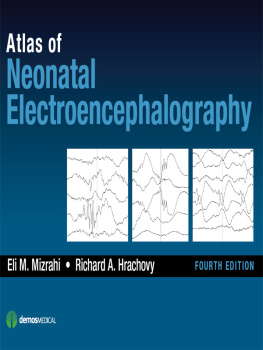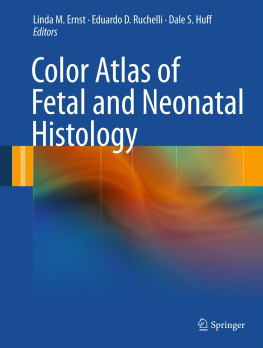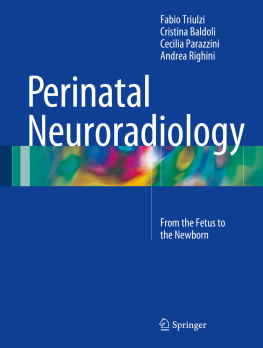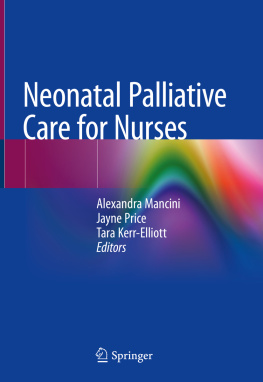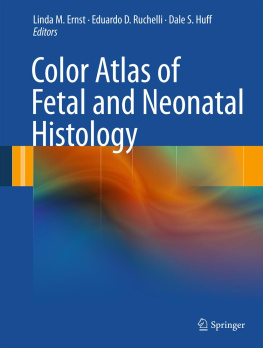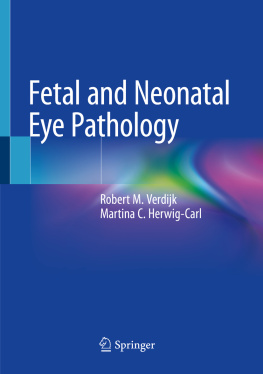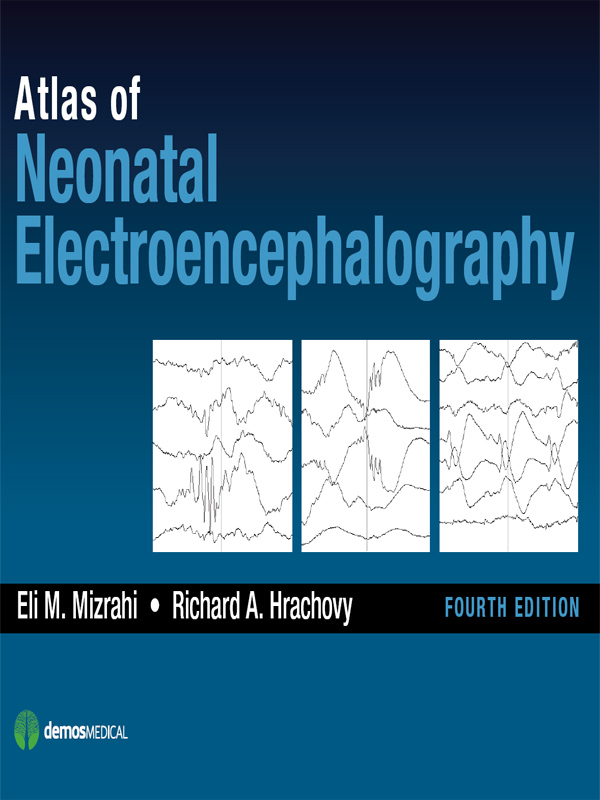ATLAS OF NEONATAL ELECTROENCEPHALOGRAPHY
ATLAS OF NEONATAL ELECTROENCEPHALOGRAPHY
Fourth Edition
Eli M. Mizrahi, MD
Chair, Department of Neurology
Professor of Neurology and Pediatrics
Baylor College of Medicine
Houston, Texas
Richard A. Hrachovy, MD
Distinguished Emeritus Professor
Department of Neurology
Baylor College of Medicine
Houston, Texas

Contents
Guide
Visit our website at www.demosmedical.com
ISBN: 9781620700679
e-book ISBN: 9781617052347
Acquisitions Editor: Beth Barry
Compositor: diacriTech
2016 Demos Medical Publishing, LLC. All rights reserved. This book is protected by copyright. No part of it may be reproduced, stored in a retrieval system, or transmitted in any form or by any means, electronic, mechanical, photocopying, recording, or otherwise, without the prior written permission of the publisher.
Medicine is an ever-changing science. Research and clinical experience are continually expanding our knowledge, in particular our understanding of proper treatment and drug therapy. The authors, editors, and publisher have made every effort to ensure that all information in this book is in accordance with the state of knowledge at the time of production of the book. Nevertheless, the authors, editors, and publisher are not responsible for errors or omissions or for any consequences from application of the information in this book and make no warranty, expressed or implied, with respect to the contents of the publication. Every reader should examine carefully the package inserts accompanying each drug and should carefully check whether the dosage schedules mentioned therein or the contraindications stated by the manufacturer differ from the statements made in this book. Such examination is particularly important with drugs that are either rarely used or have been newly released on the market.
Library of Congress Cataloging-in-Publication Data
Mizrahi, Eli M., author.
Atlas of neonatal electroencephalography / Eli M. Mizrahi, Richard A. Hrachovy.Fourth edition. p. ; cm.
Includes bibliographical references and index.
ISBN 978-1-62070-067-9ISBN 978-1-61705-234-7 (eISBN)
I. Hrachovy, Richard A., 1948, author. II. Title.
[DNLM: 1. ElectroencephalographyAtlases. 2. Infant, Newborn, DiseasesdiagnosisAtlases. 3. Infant, Newborn. 4. Neurologic ExaminationAtlases. WL 17]
RJ290.5
618.928047547--dc23
2015026903
Printed in the United States of America by Publishers Graphics.
15 16 17 18/5 4 3 2 1
Contents
Preface
The practice of neonatal electroencephalography (EEG) combines clinical medicine and biomedical technology. It is based on the understanding of the general principles of EEG interpretation and age-dependent brain development unique to the neonatal period. However, this practice is limited by a gap in our knowledge between well-characterized features of some neonatal EEG findings and those that have yet to be clearly defined by clinical investigations. In considering these factors, we have written the Atlas of Neonatal Electroencephalography, Fourth Edition, to be a single-source reference concerning the practice of neonatal EEG based upon available information and current guidelines. Through text, tables, and samples of EEG recordings, we have tried to present a comprehensive view of the clinical practice of neonatal EEG for neurologists and clinical neurophysiologists; for trainees in neurology, clinical neurophysiology, and epilepsy; and for electroneurodiagnostic technologists.
As in the third edition of the Atlas (Mizrahi et al., 2004), this edition consists of chapters concerning the approach to visual analysis, techniques of recording, artifacts of noncerebral origin, age-dependent normal findings, patterns of uncertain diagnostic significance, age-dependent abnormal EEG findings, and seizures. Chapters consist of explanatory text, tables, a list of figures, and the sample EEGs themselves with their legends. For this new edition, the text and references have been updated and new EEG samples have been added to supplement those from the third edition.
We have presented information based upon the available referenced literature from a diverse group of clinical investigators representing several generations of neonatal neurophysiologists. In considering the aspects of neonatal EEG for which no studies are available and for which unresolved controversies persist, we have provided our own opinions. These have been formulated within our group and based upon our collective experience. Peter Kellaway, PhD, coauthored the third edition which went to press just prior to his death in 2003. He was integrally involved in the writing of that edition. As a pioneer in the development of neonatal and pediatric clinical neurophysiology his contributions to the third edition were invaluable. His ideas and concepts related to the practice of neonatal EEG that had been incorporated in the third edition and are carried forward in this current edition. In addition, over the years, we have written a number of articles, chapters, and reviews on neonatal and pediatric EEG and we have drawn from these works (Hrachovy et al., 1990; Kellaway, 2003; Kellaway and Hrachovy, 1982; Mizrahi, 1986; Mizrahi and Kellaway, 1998; Mizrahi et al., 2011).
The third edition of the Atlas was produced at a time when many laboratories were transitioning from analog recording devices to digital instrumentation. This is for the most part now complete with virtually all neonatal EEG recordings performed on digital equipment. Our figures still represent a mixture of EEG samples derived both from analog-derived pen-and-ink and digital computer-based recordings. All of our recordings are presented as they were recorded in the course of clinical practice in our laboratory or at the bedside in the neonatal intensive unit. Unless otherwise indicated in figure legends, the recording parameters for all EEG channels on all samples are: sensitivity, 7 V/mm; high-frequency filter, 70 Hz; low-frequency filter, 0.5 Hz (analog recordings), 1.0 Hz (digital recordings identified by the use of T7/T8 electrode designation rather than T3/T4); 60 Hz filter on; paper speed 30 mm/sec (analog recordings) and 10 sec/screen (digital recordings). Electrode placements for all recordings include: F1, F2, T3, T4, C3, C4, CZ, O1, O2 although additional electrodes may also have been placed. On some recordings T3 and T4 are designated as T7 and T8 consistent with recent guidelines by the American Clinical Neurophysiology Society which renamed these placements (ACNS, 2006a). They represent the same brain region. The abbreviations EKG and ECG are used interchangeably for electrocardiogram.
We realize the technical field of neonatal neurophysiology is rapidly expanding with the now almost routine use of bedside EEG-video monitoring and the increasing interest in the application of amplitude integrated EEG (aEEG) or cerebral function monitoring (CFM). We have provided some technical information concerning the methodology of EEG-video bedside monitoring but have not specifically addressed aEEG which is considered in detail elsewhere by expert investigators in that field (Boylan et al., 2013; Glass et al., 2013; Hellstrom-Wellas et al., 2003; Shah and Mathur, 2014; Shellhaas et al., 2007).

